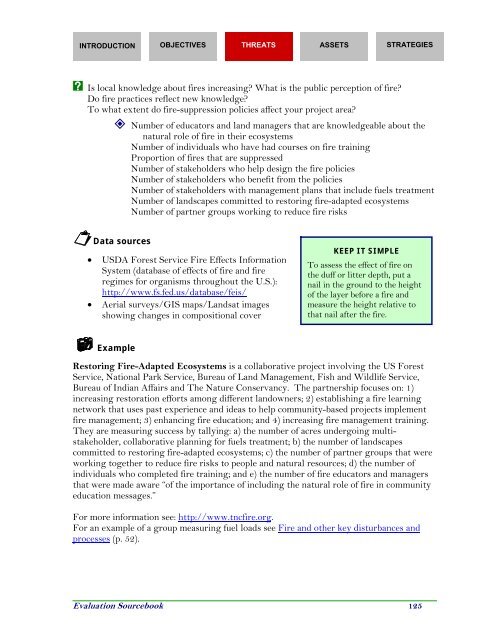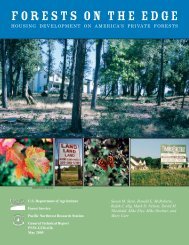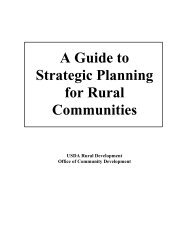Evaluation Sourcebook (.pdf) - School of Natural Resources and ...
Evaluation Sourcebook (.pdf) - School of Natural Resources and ...
Evaluation Sourcebook (.pdf) - School of Natural Resources and ...
- No tags were found...
You also want an ePaper? Increase the reach of your titles
YUMPU automatically turns print PDFs into web optimized ePapers that Google loves.
INTRODUCTION OBJECTIVES THREATS ASSETS STRATEGIESX Is local knowledge about fires increasing? What is the public perception <strong>of</strong> fire?Do fire practices reflect new knowledge?To what extent do fire-suppression policies affect your project area? Number <strong>of</strong> educators <strong>and</strong> l<strong>and</strong> managers that are knowledgeable about thenatural role <strong>of</strong> fire in their ecosystemsNumber <strong>of</strong> individuals who have had courses on fire trainingProportion <strong>of</strong> fires that are suppressedNumber <strong>of</strong> stakeholders who help design the fire policiesNumber <strong>of</strong> stakeholders who benefit from the policiesNumber <strong>of</strong> stakeholders with management plans that include fuels treatmentNumber <strong>of</strong> l<strong>and</strong>scapes committed to restoring fire-adapted ecosystemsNumber <strong>of</strong> partner groups working to reduce fire risksData sources• USDA Forest Service Fire Effects InformationSystem (database <strong>of</strong> effects <strong>of</strong> fire <strong>and</strong> fireregimes for organisms throughout the U.S.):http://www.fs.fed.us/database/feis/• Aerial surveys/GIS maps/L<strong>and</strong>sat imagesshowing changes in compositional coverKEEP IT SIMPLETo assess the effect <strong>of</strong> fire onthe duff or litter depth, put anail in the ground to the height<strong>of</strong> the layer before a fire <strong>and</strong>measure the height relative tothat nail after the fire.ExampleRestoring Fire-Adapted Ecosystems is a collaborative project involving the US ForestService, National Park Service, Bureau <strong>of</strong> L<strong>and</strong> Management, Fish <strong>and</strong> Wildlife Service,Bureau <strong>of</strong> Indian Affairs <strong>and</strong> The Nature Conservancy. The partnership focuses on: 1)increasing restoration efforts among different l<strong>and</strong>owners; 2) establishing a fire learningnetwork that uses past experience <strong>and</strong> ideas to help community-based projects implementfire management; 3) enhancing fire education; <strong>and</strong> 4) increasing fire management training.They are measuring success by tallying: a) the number <strong>of</strong> acres undergoing multistakeholder,collaborative planning for fuels treatment; b) the number <strong>of</strong> l<strong>and</strong>scapescommitted to restoring fire-adapted ecosystems; c) the number <strong>of</strong> partner groups that wereworking together to reduce fire risks to people <strong>and</strong> natural resources; d) the number <strong>of</strong>individuals who completed fire training; <strong>and</strong> e) the number <strong>of</strong> fire educators <strong>and</strong> managersthat were made aware “<strong>of</strong> the importance <strong>of</strong> including the natural role <strong>of</strong> fire in communityeducation messages.”For more information see: http://www.tncfire.org.For an example <strong>of</strong> a group measuring fuel loads see Fire <strong>and</strong> other key disturbances <strong>and</strong>processes (p. 52).<strong>Evaluation</strong> <strong>Sourcebook</strong> 125






